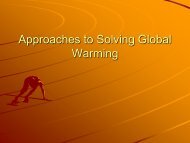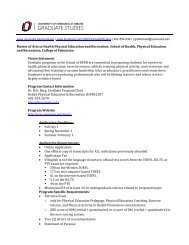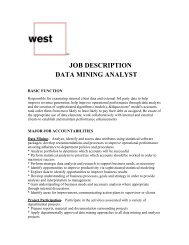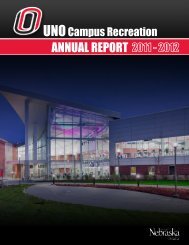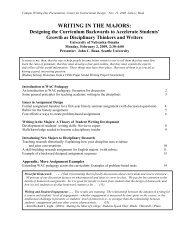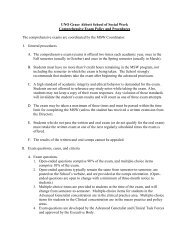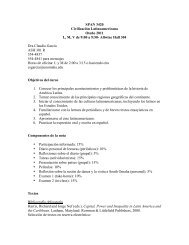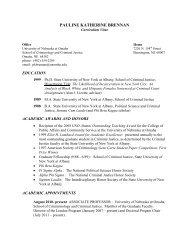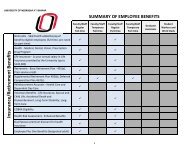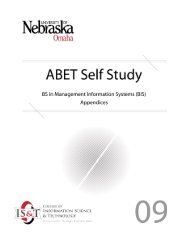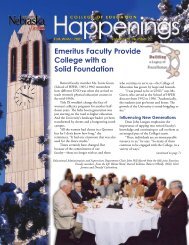Hotwork Permits - University of Nebraska Omaha
Hotwork Permits - University of Nebraska Omaha
Hotwork Permits - University of Nebraska Omaha
You also want an ePaper? Increase the reach of your titles
YUMPU automatically turns print PDFs into web optimized ePapers that Google loves.
<strong>University</strong> <strong>of</strong> <strong>Nebraska</strong> at <strong>Omaha</strong><br />
HOT WORK PERMIT<br />
(FIRE PREVENTION IN CUTTING AND WELDING PROCESSES)<br />
Hot Work Permit<br />
Hot Work Supervisors<br />
POLICY<br />
It is the policy <strong>of</strong> the <strong>University</strong> <strong>of</strong> <strong>Nebraska</strong> at <strong>Omaha</strong> (UN<strong>Omaha</strong>) to minimize the risk <strong>of</strong> fire<br />
caused by cutting and welding operations. This procedure applies to all employees and any<br />
contractors working on projects under the control <strong>of</strong> a UN<strong>Omaha</strong> department. Cutting and<br />
welding includes soldering and brazing. Special precautions are also required for spark<br />
producing equipment in certain areas where flammable mixtures may exist. This policy does not<br />
apply to maintenance shops, laboratories, research areas or new construction where hot work is<br />
routinely performed.<br />
PROCEDURES<br />
To reduce the risk <strong>of</strong> fires caused by cutting and welding using oxy-fuel gas flames or electric<br />
arc welding equipment.<br />
1. General use:<br />
A. A Hot Work Permit form must be completed or posted at the Hot Work work area. UNO<br />
construction engineers, managers, shop supervisors must call Campus Security with the<br />
information regarding each permit prior to the start <strong>of</strong> work.<br />
B. Combustible material must be shielded or removed when cutting or welding is performed.<br />
C. Cutting or welding will NOT be allowed when:<br />
1. The proximity <strong>of</strong> nearby combustible solids, liquids or dusts<br />
which cannot be removed or properly protected.<br />
2. Flammable gases or vapors or oxygen enriched atmospheres<br />
are present or may develop during the course <strong>of</strong> the operation.<br />
3. The sprinkler protection is impaired in the buildings or area<br />
where the hot work is to be performed unless approved by the<br />
Environmental Health & Safety department.<br />
4. In areas near the storage <strong>of</strong> large quantities <strong>of</strong> exposed, readily<br />
ignitible materials such as paper.
5. In areas that do not comply with this policy.<br />
D. Only OSHA approved apparatus, such as torches, manifolds,<br />
regulators, or pressure reducing valves and acetylene generators will<br />
be used.<br />
E. Personnel performing cutting and welding and their supervisors must<br />
be trained in the safe operation <strong>of</strong> their equipment, the safe use <strong>of</strong> the<br />
process and emergency procedures in the event <strong>of</strong> a fire.<br />
F. Cutting or welding will be permitted only in areas that are or have been<br />
made firesafe. Cutting and welding will be done in:<br />
1. A specific area designed or approved for such work.<br />
2. When work cannot be moved practically, as in most<br />
construction work, the area shall be made firesafe by removing<br />
combustibles or protecting combustibles from ignition sources.<br />
G. Fire watchers shall be required whenever cutting or welding is<br />
performed in locations where a fire might develop.<br />
H. “Hot tapping” or other cutting and welding on a flammable gas or<br />
liquid transmission or distribution utility pipeline shall be performed<br />
by a crew qualified to make hot taps.<br />
I. Oxy-gas cylinders located at the site will be connected for use except<br />
that enough additional cylinders may be stored at the site to furnish<br />
approximately one day‟s consumption <strong>of</strong> each as used. Other<br />
cylinders will be stored in an approved storage area, preferably<br />
outdoors but not near a building exit.<br />
J. Oxy-gas cylinders in excess <strong>of</strong> 40 lb.(18 kg.) total weight being<br />
transported to or from the site will be carried and secured on a hand<br />
truck or motorized truck.<br />
K. Hoses will be located and protected so that they will not be physically<br />
damaged. This equipment will be equipped with approved flash back<br />
arrestors.<br />
L. Hot Work <strong>Permits</strong> are required for spark producing equipment such as<br />
drills, saws, grinders, etc. in flammable storage areas. On campus this<br />
includes flammable storage rooms in Allwine Hall, Peter Kiewit<br />
Institute, Durham Science Center, and Annex 31. Contact EHS for<br />
clarification.
2. Responsibility <strong>of</strong> UNO supervisor/manager/construction engineer:<br />
A. The „supervisor” is responsible for authorizing cutting and welding<br />
operations and issuing Hot Work <strong>Permits</strong>.<br />
B. “Supervisors” must review project conditions with a contractor<br />
concerning flammable materials or hazardous conditions <strong>of</strong> which they<br />
may not be aware. This includes gas lines in the area.<br />
C. The UNO “supervisor” will:<br />
1. Communicate the information on the Hot Work Permit to the<br />
Campus Security Dispatcher at 4-2648 prior to the start <strong>of</strong> the<br />
work.<br />
2. Determine that fire protection and extinguishing equipment are<br />
properly located at the site.<br />
3. See that a fire watch is available at the site where required (see<br />
Item # 4, page 5 for fire watch responsibilities).<br />
D. Before cutting or welding is permitted, the area will be inspected by<br />
the “supervisor” to ensure that it is a firesafe area. This individual<br />
will designate precautions to be followed by completing and posting<br />
the Hot Work Permit. The “supervisor” will sign and post the permit<br />
and shall verify the following:<br />
1. Cutting and welding equipment is in satisfactory operating<br />
condition and in good repair.<br />
2. Where practical, all combustibles will be relocated at least 35<br />
feet (11 m) horizontally from the work site. Where relocation<br />
is impractical, combustibles will be protected with flamepro<strong>of</strong>ed<br />
covers or otherwise shielded with metal or fireresistant<br />
guards or curtains. Edges <strong>of</strong> covers at the floor will<br />
be tight to prevent sparks from entering under the cover. This<br />
precaution is also important at overlaps where several covers<br />
are used to protect a large pile.<br />
3. Combustible materials on the floor such as paper clippings,<br />
wood shavings, or textile fibers are swept for a radius <strong>of</strong> 35<br />
feet (11 m). Combustible floors (except wood on concrete)<br />
will be kept wet or protected by fire-resistant shields. Where<br />
floors have been wet down, personnel operating arc<br />
welding or cutting equipment shall be protected from possible<br />
shock.
4. Openings or cracks in walls, floors, or ducts within 35 feet (11<br />
m) <strong>of</strong> the site are covered to prevent the passage <strong>of</strong> sparks<br />
to adjacent areas.<br />
5. Conveyor systems that might carry sparks to distant<br />
combustibles are to be suitably protected.<br />
6. Cutting or welding on pipes or other metal contact with<br />
combustible walls, partitions, ceilings or ro<strong>of</strong>s will not be<br />
undertaken if the work is close enough to cause ignition by<br />
conduction.<br />
7. Fully charged and operable fire extinguishers, appropriate for<br />
the type <strong>of</strong> possible fire, are available at the work area. Call<br />
Environmental Health & Safety to obtain additional fire<br />
extinguishers. Contractors are required to provide their own<br />
fire extinguishers.<br />
8. When welding or cutting is done in close proximity to a<br />
sprinkler head, a wet rag will be laid over the head and then<br />
removed at the conclusion <strong>of</strong> the cutting or welding operations.<br />
Special precautions will be taken to avoid accidental operation<br />
<strong>of</strong> automatic fire detection or suppression systems – e.g., halon<br />
system in computer room.<br />
9. If smoke or heat detectors are in the immediate vicinity <strong>of</strong> the<br />
work, notify Campus Security prior to the hot work and<br />
describe exactly where the detectors are located. Only the<br />
UNO fire alarm contractor is authorized to disarm fire<br />
detection equipment.<br />
10. The cutter/welder and or fire watch knows the location <strong>of</strong> the<br />
nearest campus phone, the emergency campus phone<br />
number (4-2911), has verified the phone is operational, and<br />
knows the location <strong>of</strong> the nearest manual fire alarm pull<br />
station.<br />
3. Responsibility <strong>of</strong> cutter/welder:<br />
A. The cutter or welder will handle the equipment safely.<br />
1. Have approval by the UNO “supervisor” before starting to cut<br />
or weld.<br />
2. Cut or weld only so long as conditions are unchanged from<br />
those under which approval was granted.
B. No cutting or welding will be performed within one hour <strong>of</strong> quitting<br />
time. The work area must also be attended during c<strong>of</strong>fee and lunch<br />
breaks, by either the craftsman or the fire watch.<br />
C. The following conditions regarding gas cylinders will be observed:<br />
1. Cylinder valves will be closed when equipment is unattended.<br />
2. Where caps are provided for valve protection, such caps will be<br />
in place except when the cylinders are in service or connected<br />
ready for service.<br />
3. Cylinders will be secured so that they cannot be knocked over.<br />
D. Contact Campus Security when the cutting/welding work for which<br />
the Hot Work<br />
4. Responsibility <strong>of</strong> the fire watch:<br />
A. Fire watch will:<br />
1. Be trained in the use <strong>of</strong> fire extinguishing equipment, including<br />
practice on test fires.<br />
2. Be familiar with facilities and procedures for sounding an alarm<br />
in the event <strong>of</strong> a fire.<br />
3. Watch for fires in all exposed areas and try to extinguish them<br />
only when obviously within the capacity <strong>of</strong> the equipment<br />
available, or otherwise pull the nearest fire alarm manual pull<br />
station.<br />
4. Maintain the watch for at least one hour after completion <strong>of</strong><br />
cutting or welding operations to detect and extinguish<br />
smoldering fires.<br />
5. Responsibility <strong>of</strong> Campus Security:<br />
A. Campus Security Dispatcher maintains a log for Hot Work <strong>Permits</strong>,<br />
records and passes on Hot Work Permit status as appropriate.<br />
B. After the stated finish time on permit, Campus Security will perform<br />
periodic walkthroughs <strong>of</strong> the hot work area for four (4) hours.<br />
C. After four (4) hours, Campus Security will perform a final<br />
walkthrough, remove and sign the Hot Work Permit on the “final
checkup” line. The completed Hot Work Permit will be forwarded to<br />
the Environmental Health & Safety secretary.<br />
9/21/01<br />
UNO Hot Work Supervisors<br />
Hot Work Permit Numbers will only be issued to UNO personnel, not outside contractors (all<br />
outside contractors have a UNO contact).<br />
NAME:<br />
Cell phone number:<br />
Adler, Larry 960-9816<br />
Baker, Butch 960-9817<br />
Burr, Walt 960-9819<br />
Campbell, Bill 960-9815<br />
Conley, Steve 960-9810<br />
Cross, Toby 4-3600<br />
Ferree, Dave 960-9822<br />
Meradith, Dave 960-9825<br />
Moore, Dennis 960-9826<br />
Morgan, Larry 960-9812<br />
Simpson, Don 960-9830<br />
Wawrzynkiewicz, Tom 960-9831<br />
Issuing a Hot Work Permit number is NEVER an emergency. If you are unsure <strong>of</strong> the protocol,<br />
contact: Stan Schleifer, EHS.<br />
1/7/04



